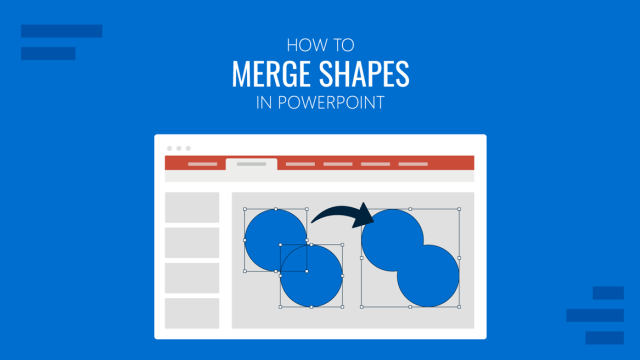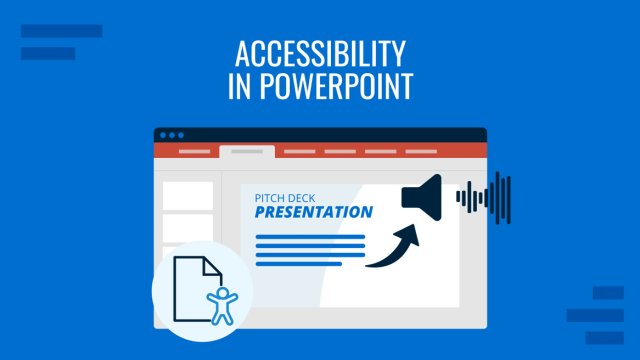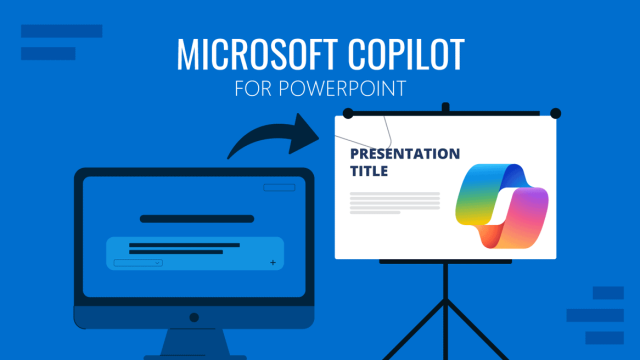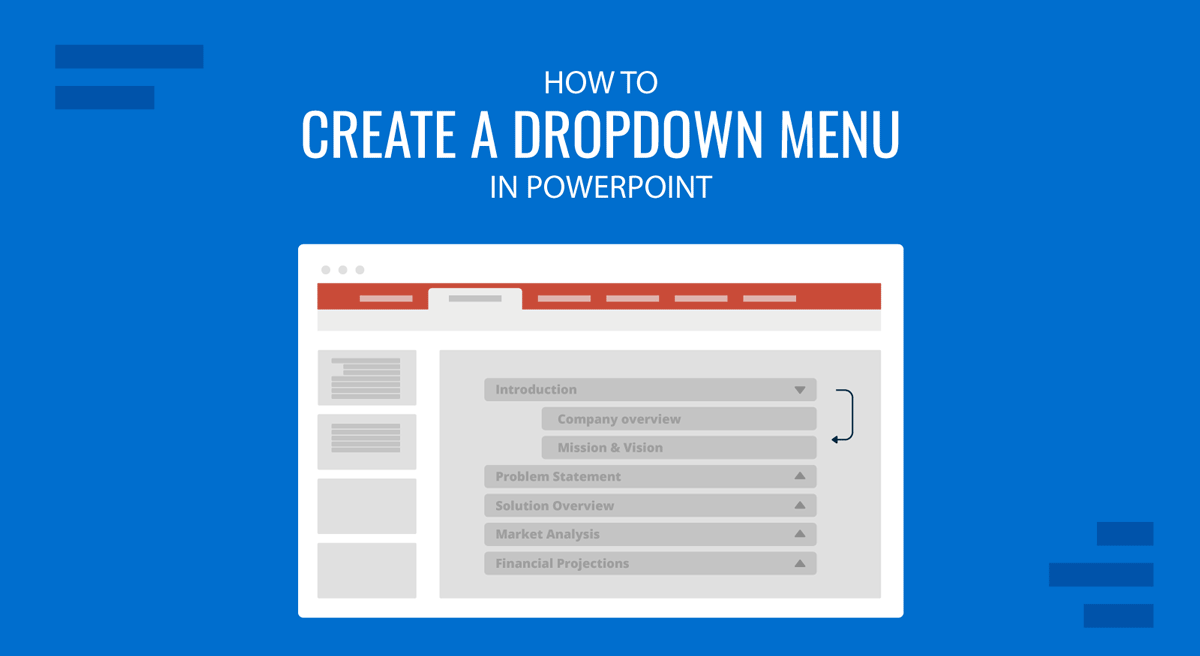
A common issue that many PowerPoint users face is the inability to neatly organize important text in a layout that is easy to follow for the audience. Accommodating information in a cohesive interface can be difficult for the average PowerPoint user to create. One easy method to overcome this problem is creating a PowerPoint drop-down menu.
What is a Dropdown Menu?
A dropdown menu is an expandable menu that reveals information in sections that can be expanded or contracted upon selection. Such menus can be triggered to open and close with a click or mouse hover. It is a user interface element that allows users to select one option from a list of choices that appear on the screen once the menu is activated. It helps organize content, reduce clutter, and improve navigation. In PowerPoint, a drop-down menu can create interactive presentations by allowing users to navigate to different slides or sections seamlessly.
Benefits of using a Dropdown Menu in PowerPoint
A dropdown menu in PowerPoint can enhance presentations by providing a clean, interactive way to navigate slides. This feature is handy for explaining topics sequentially, for interactive training modules, business presentations, and e-learning materials.
Enhanced Navigation: A dropdown menu helps streamline navigation, making it easier for end users to navigate sections of a PowerPoint presentation effectively. The navigation buttons can be customized for your templates in PowerPoint, be it a PowerPoint template or Google Slides templates used with PowerPoint. The customization can ensure that the presenter is able to manage the buttons according to specific needs for enhanced navigation.
Improved Organization: By grouping related options within a dropdown menu, presentations can appear more structured. If you’re wondering how to make a presentation structured, using dropdown menus can be one effective way of doing that.
Easy to Present: A dropdown in PowerPoint can make a presentation easy to present due to its organized layout and easy navigation. Providing a sequential and collapsable interface can make the presenter’s job easy. Provide an organized layout that can be easy to present from the start to the time you end a presentation.
Space Optimization: Dropdown menus in PowerPoint can help optimize slide space. Instead of listing multiple navigation buttons, a drop-down menu saves space and reduces clutter on slides. Like dashboard layouts, dropdown menus provide the utility to accommodate more content in less space or use interconnected slides for easy navigation between key subtopics while displaying key information in a single slide layout.
Interactivity: A well-designed drop-down menu increases audience engagement by making the PowerPoint presentation more interactive and user-friendly. This also eliminates the need to move back and forth between different slides to jump to relevant subtopics.
Customization: You can personalize the menu design and functionality to match your topic and objectives. Such customization can also be aligned with a specific presentation theme with colors and branding that reflect the topic and organization’s niche.
Visual Appeal: Adding a drop-down menu can make your presentation look polished and enhance its overall visual appeal. The easy navigation and interconnected information in a neat-looking layout can also make your slides look professional and impressive.
Easy to Follow: Using a drop-down list in PPT can make the presentation easy for the audience to follow. Information presented sequentially can also be easier to follow, especially when the slide is uncluttered, with only relevant information appearing in chunks according to need. This means that the slide will not be cluttered with too much information simultaneously, and only relevant section(s) will be expanded for explanation to the audience.
How to Create a Dropdown PowerPoint Menu with Linked Slides
While PowerPoint doesn’t offer a built-in drop-down menu feature, you can create one using linked content, action buttons, animations, and triggers. Some of these can also be developed using easy-to-edit PowerPoint templates and VBA scripts.
Step 1: Plan Your Drop-Down Menu
Before you start, decide which slides or sections your drop-down menu will link to. Having a clear structure will help ensure a smooth user experience. In the example below, we will create a dropdown menu with vertical menus and expandable horizontal boxes within each menu. For this purpose, we will use the Horizontal Accordion PowerPoint Template.
Step 2: Create the Menu Buttons
While the template shown below already includes menu buttons, you can also create your own using PowerPoint shapes.
- If you wish to create your own buttons, go to Insert -> Shapes and select a shape like a rectangle.
Label the shape with text and use Shape Fill, Shape Outline, and Text Styles via the Shape Format tab to give your menu buttons a polished look.
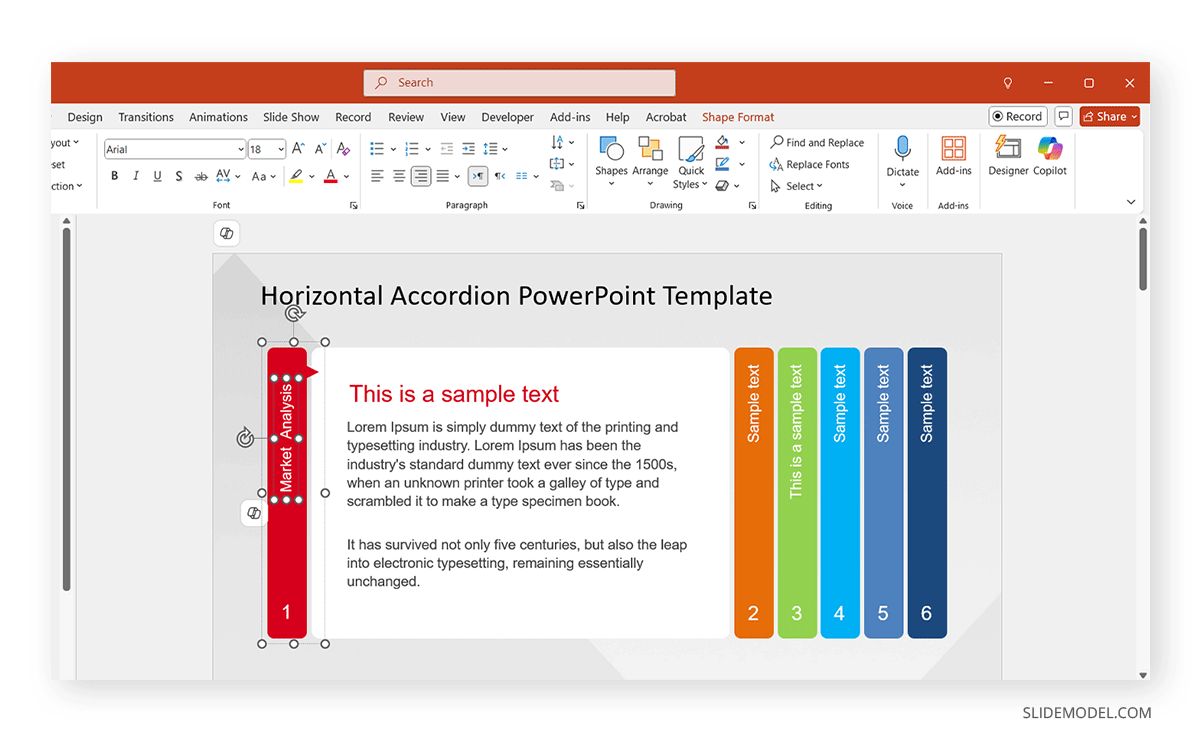
Step 3: Add Drop-Down Sections
Create a dedicated slide with an expandable menu for each button. In the template below, each button has a dedicated slide with an expandable menu. To give this effect, you can use a shape like a rectangle and add text with a detailed explanation of the topic. For example, if your slide has six buttons, there will be one for each button with an expanded section linked with the main slide to give the dropdown effect.
- Insert additional shapes beneath the menu button, and these will serve as the menu options.
- Align the shapes properly under the menu button to create a drop-down effect.
- Customize the appearance using formatting tools to match your presentation’s theme.
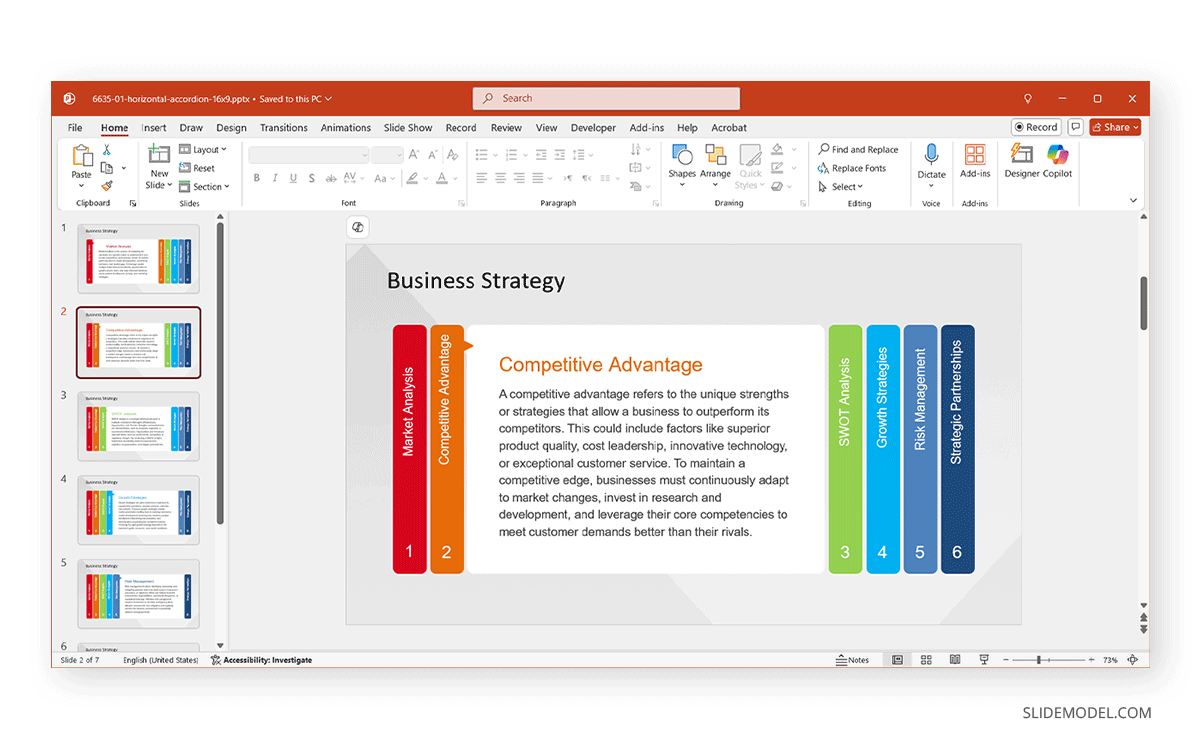
Step 4: Create Main Slide
Duplicate one of your slides and align all buttons in one place to create the effect of a slide button menu. In the example below, we duplicated Slide 1 and aligned all the buttons using drag-and-drop to create a main slide.
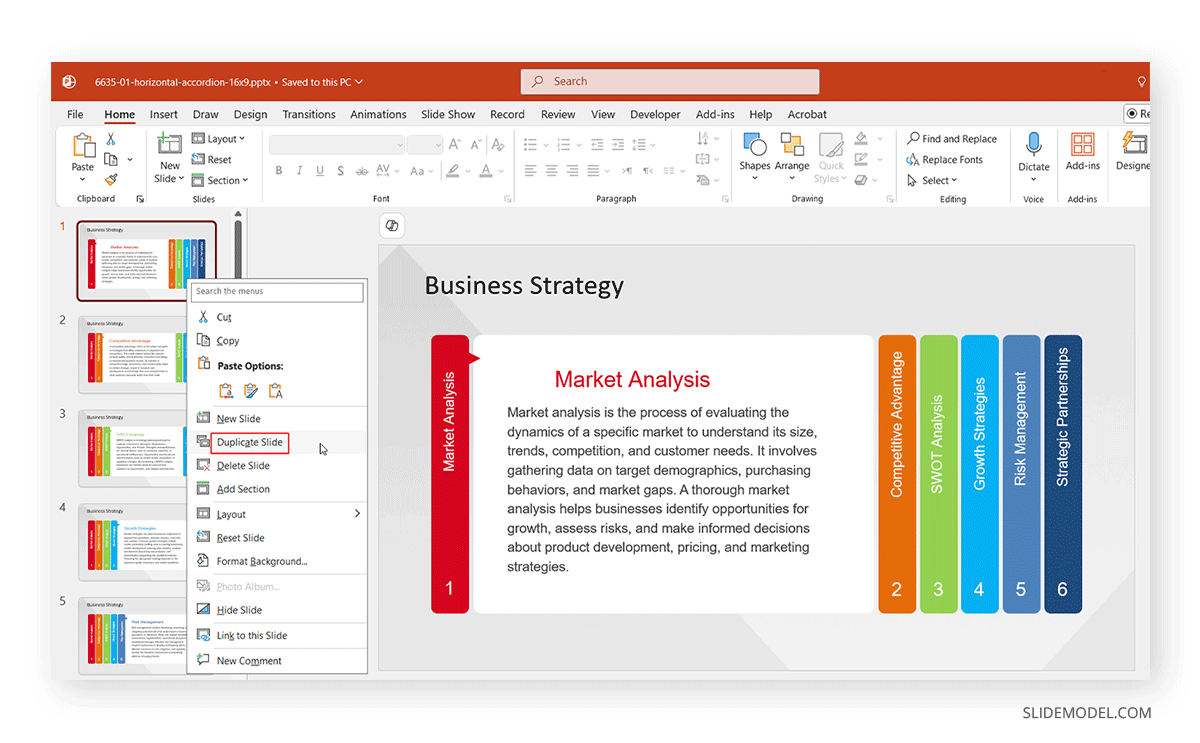
Step 5: Link Main Slide with Content Slides
Once you have a main slide with buttons, link it to the respective content slides.
Select a menu button shape, go to Insert -> Link -> Insert Link -> Place in This Document, and select the slide you want the button to navigate to once it is clicked. Repeat this process for each menu option.
Note: All slides are automatically linked to the template mentioned in this post. Duplicating Slide 1 and arranging the buttons together using drag and drop will give you a linked dropdown menu with six other slides. This is also a very convenient method for an opening slide. If you want to learn how to start a presentation with style, using an organized dropdown menu such as this one is one way of doing it.
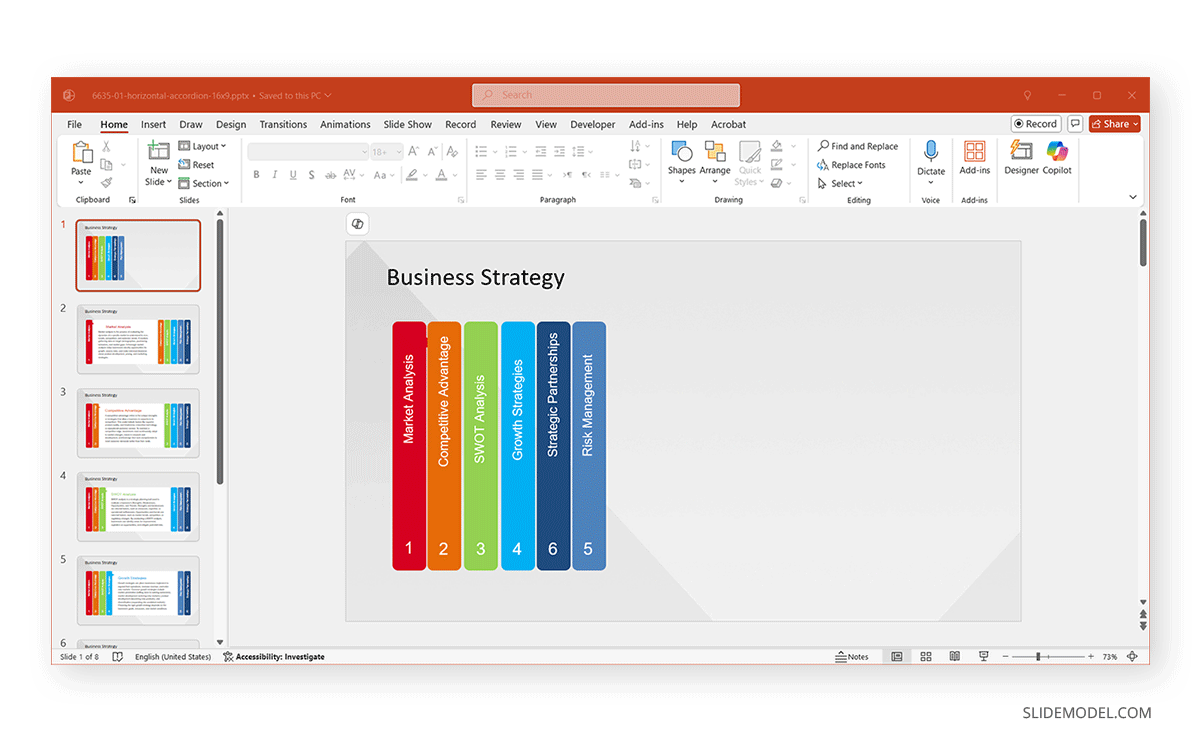
Step 6: Use Animations to Create the Drop-Down Effect
Select all the menu button shapes and add an animation to each.
- Go to the Animations tab and choose the Appear or Fade effect.
- Click the Animation Pane and set the trigger for the animation.
- Select Trigger -> On Click of and choose the menu button title from the menu.
- Adjust the animation timing for a smooth effect.
Note: If you use the template in this example, you can optionally skip triggers and add Animations to linked slides.
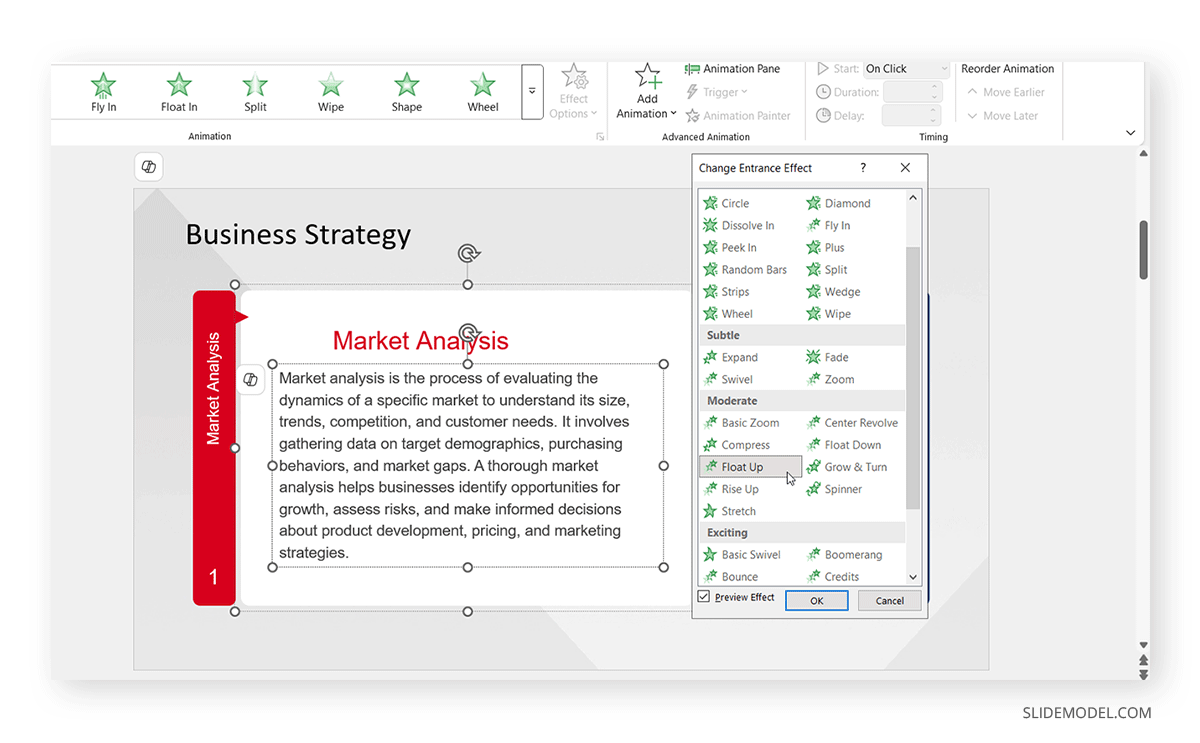
Step 7: Test Your Dropdown Menu
Switch to Slide Show mode and click the menu buttons. Your menu should drop down, revealing the options. Clicking an option should take you to the corresponding slide.
How to Create a Drop-Down Menu in PowerPoint Using VBA Script
If you want to use VBA (Visual Basic for Applications) to create dropdown menus in PowerPoint, follow the simple steps below.
Step 1: Access the VBA Editor
Open the PowerPoint VBA editor by going to Developer -> Visual Basic.
Note: If the Developer tab isn’t enabled, you can enable it via File -> Options -> Customize Ribbon.
Step 2: Insert Module and VBA Code
Go to Insert -> Module to add a new module and paste your VBA code. We have added a sample code below that you can use and customize.
(script)
Step 3: Run the Macro
- After closing the VBA editor, go to Developer -> Macros.
- Select the Name of the Macro and click Run.
This script will create a button that toggles the visibility of a drop-down menu, offering a dynamic and interactive experience.
Final Words
Creating a drop-down menu in PowerPoint using hyperlinks and animations can enhance your presentation and keep it organized. Such a presentation can be easy to present and gives the audience a clean layout to follow the presented information. Such an uncluttered layout can enable you to present complex ideas sequentially while revealing only the discussed subtopic by expanding the dropdown menu according to need. This can help you create engaging presentations. While PowerPoint has no native drop-down menu feature, this workaround helps make presentations more professional and engaging. Experiment with different animations and styles to best fit your presentation needs. While you can use triggers, animations, and VBA code for designing such slides, your task can be much easier using Hierarchy PPT Templates, which can be modified to make dropdown lists with little modification (as shown in the first example in this tutorial). Using such templates can also make your job easy in creating and experimenting with dropdown menus. You will be able to focus on the content rather than the design of the slides.
